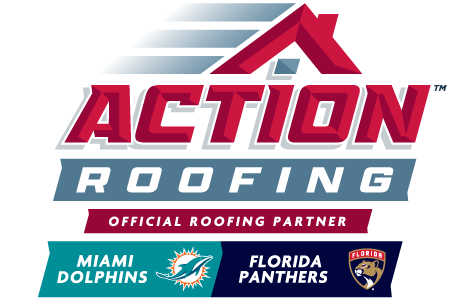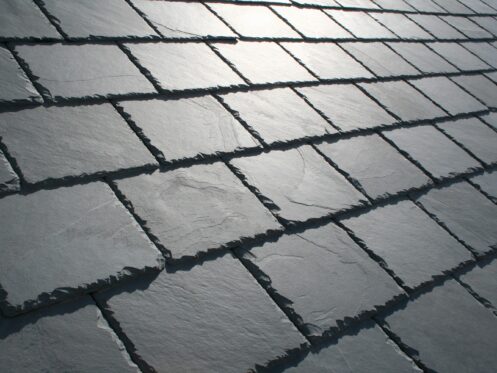There are various roofing material options available when replacing your roof. Which option you choose makes a difference in how long you can expect your new roof to last, how much upkeep or repairs it may need, and how much the roof replacement costs.
The choice of roofing materials also makes a difference in your home’s energy efficiency and how much it costs to run your air conditioning and keep your house cool.
How Roofing Impacts the Energy Efficiency of a Home
Roofing has a much bigger impact on a home’s energy efficiency than most people realize, especially in South Florida’s hot, tropical climate. The main issue is the amount of heat a roof can absorb. It’s not uncommon for a roof to be 80 to 100 degrees hotter than the outdoor air temperature during the afternoon and early evening. As the roof heats up, it causes your attic space to become far hotter as well.
This is especially true if the attic and roof don’t have sufficient ventilation. The heat that builds up in the attic then causes the temperature in the rest of the house to continually increase, resulting in the AC system having to do more work and run more frequently.
Factors That Impact the Energy Efficiency of a Roof
Two main factors determine how energy efficient any type of roofing material is: solar reflectance and thermal emissivity. Solar reflectance refers to how well any material reflects the sun’s rays.
Roofing materials with a low solar reflectance are inefficient, as they absorb a large percentage of solar energy and quickly get extremely hot. Alternatively, materials with a higher solar reflectance stay cooler, as they reflect more solar energy than they absorb. In terms of solar reflectance, one factor that always plays a role is the color of the roof. Dark colors absorb a lot of sunlight, while lighter colors are much better at reflecting it.
Thermal emissivity refers to how quickly and effectively a material releases the heat it absorbs, i.e., how fast it can cool down. Roofing materials with a high emissivity cool much quicker, especially once the sun goes down.
One other factor that impacts the energy efficiency of a roof is its pitch or how much slope it has. The reason is that the slope affects the angle at which sunlight hits the roof. In hot climates, flat or low-sloped roofs receive less direct sunlight during the hottest parts of the day and are thus more efficient than roofs with a steep pitch or slope.
Understanding the Solar Reflectance Index
The Solar Reflectance Index (SRI) is a metric used to measure roofing material’s ability to reflect sunlight and emit heat. That means it considers both solar reflectance and thermal emissivity, making it a useful measurement for expressing overall energy efficiency. The SRI scale goes from zero to 100, with zero being the least efficient and 100 being the most efficient. When deciding which roofing materials to use, you want to find something with as high of an SRI as possible.
The Most Energy-Efficient Roofing Materials
The three main roofing materials used on sloped roofs are shingles, tiles, and metal roofing. Each type has advantages and drawbacks regarding price, longevity, durability, and weight. They can also vary quite a bit in terms of energy efficiency.
Metal Roofing
Metal roofing is often the most energy-efficient choice for homes in hot climates. The metal itself is very reflective, resulting in the roof not absorbing that much heat. In fact, metal roofing is so reflective that you often can’t stand on it during the middle of the day due to how much heat is reflected off the roof.
Many types of metal roofing also have a reflective coating that helps to improve energy efficiency further. Some metal roofing options have an SRI of over 80, depending on the roof’s slope. Alternatively, some asphalt shingles have an SRI under 10.
Metal roofing is also durable and much less likely to get damaged during a storm than other types of roofing. This is one reason why it’s generally considered the best choice for places that can experience hurricanes, tornadoes, or other severe weather. Another great thing about a metal roof is that you can typically expect it to last for 50 years or more.
Tile Roofing
Concrete, slate, and clay tiles can also be fairly efficient. While the tiles can absorb quite a bit of heat, many of them come with a reflective coating that allows them to stay cool. You can also periodically treat them with this type of coating to achieve a higher level of solar reflectance.
In terms of thermal emissivity, tiles typically outperform all other types of roofing. The way tiles sit on a roof and are stacked against each other allows air to continually flow under them, which helps the tiles to release heat and stay cooler.
Tile roofing is almost always going to be the longest-lasting option, but roof tiles can be prone to breaking if struck by flying debris. The good news in this regard is that roofers can replace any broken tiles quite easily. The main drawback when it comes to tile roofing is the cost.
Concrete tiles aren’t all that expensive, but clay and especially slate tiles are quite costly. If you switch from another type of roofing to tiles, you’ll also usually need to have your roof reinforced to ensure it can support the added weight.
Shingles
In the not-so-distant past, almost all asphalt shingles had an extremely low SRI due to how much heat asphalt absorbs. Nowadays, you can get roofing shingles coated with special granules, making them far more reflective. Some products reflect over 80% of sunlight, ensuring the roof stays cool.
While these products cost more than standard asphalt shingles, they are almost always worth the added price due to how much they will save you on your air conditioning costs. If you decide to opt for shingles, it’s also a good idea to choose a product with high impact-resistance and wind-resistance ratings, as they will be more likely to stand up during a storm.
Shingles are the most common roofing option because they are typically the least expensive choice. The flip side is that shingles can’t even begin to compare to tiles or metal roofing in terms of longevity, as most shingle roofs don’t last past 20 to 25 years.
Action Roofing is proud to be the number one roofing company in South Florida. We have locations in Pompano Beach, Ocala, and Stuart and serve residential and commercial customers throughout the region. We install and repair shingle, tile, metal, and flat roofing and offer a range of energy-efficient options suitable for any home or business.
To learn more about the roof replacement options we offer or to get help deciding which roofing option is right for you, contact us today.




